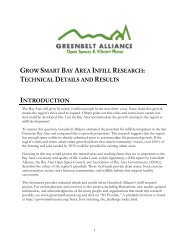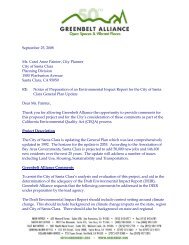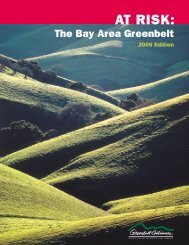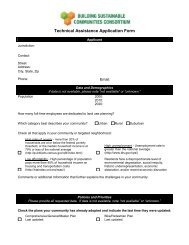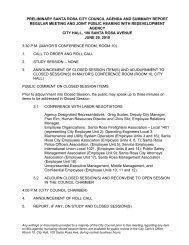Morgan Hill Agricultural Policies and Implementation Program
Morgan Hill Agricultural Policies and Implementation Program
Morgan Hill Agricultural Policies and Implementation Program
Create successful ePaper yourself
Turn your PDF publications into a flip-book with our unique Google optimized e-Paper software.
<strong>Morgan</strong> <strong>Hill</strong> <strong>Agricultural</strong> <strong>Policies</strong> <strong>and</strong> <strong>Implementation</strong> <strong>Program</strong><br />
Public Review Draft 12/22/11<br />
This definition makes no distinction as to type or scale, which may change along with national<br />
<strong>and</strong> international economic trends. Farmers can be either full-time or part-time. It does,<br />
however, exclude hobby farming, meaning farming that does not return a profit. “Supported by<br />
the local community” means that agricultural activities are accepted as part of the commerce of<br />
the area by the residents of the area, that housing is available to farm laborers <strong>and</strong> small<br />
farmers, that agriculture is integrated into the policies <strong>and</strong> regulations of the City, <strong>and</strong> that trade<br />
<strong>and</strong> commerce between the farming enterprises <strong>and</strong> the residents flourishes, through such<br />
means as local sales <strong>and</strong> farmers' markets.<br />
According to the United States Department of Agriculture (USDA) Economic Research Service<br />
(ERS), in 2008, approximately 43 percent of farmers nationally indicate that farming is their<br />
major occupation, while 42 percent state that work other than farming is their major occupation;<br />
15 percent do not consider themselves to be in the workforce. In 2008, 88 percent of all farm<br />
household income nationally came from non-farm sources. USDA ERS data indicate a long-term<br />
trend toward increasing non-farm income <strong>and</strong> decreasing farm income among United States<br />
farmers.<br />
According to a study by the University of California (UC) Davis Small Farm Center, an annual<br />
gross income level of approximately $25,000 per farm business is a threshold for sustainability.<br />
A majority of California farm businesses grossing more than $25,000 annually are profitable,<br />
based on data from the 2007 USDA Census of Agriculture. See Figure 3. As this study<br />
examines gross income, there is no implication that “a living” can be made if a farm grosses<br />
$25,000. It does imply, however, that since a profit can be expected in this situation, it is likely<br />
that small farming will continue to be an occupation, if perhaps only a part time one. Since small<br />
farming is profitable in a majority of cases if the gross revenues exceed $25,000, it is implied<br />
that the small acreages in the <strong>Morgan</strong> <strong>Hill</strong> area will continue to be farmed.<br />
Figure 3. California Gross Farm Income<br />
9 P:\19000s\19014<strong>Morgan</strong><strong>Hill</strong>\Report\MHAgReport_22Dec2011_Public_Review.doc




